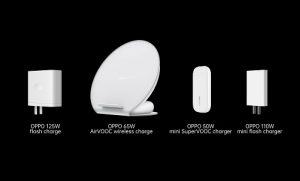
Most people will agree that Oppo is one of the leading tech companies when it comes to smartphone fast charging. The company is behind some of the best fast charging tech solutions in the market, including the Dash Charge system in One Plus phone.
Oppo’s top position has been cemented further by its release of the 125W flash charger and the 65W Air VOOC Wireless flash charge technology. The two incredible pieces of tech were announced on July 15 in Shenzhen, China, alongside the 50W mini VOOC charger and the 110W mini flash charger.
The 125W flash charger, which Oppo claims is the most advanced piece of tech in the industry, was the biggest highlight of the announcement. Oppo says at its fastest, the charger takes only 20 minutes to fully charge a 4000mAh battery and 5 minutes to charge up to 41%. Currently, the fastest charging phone, a record held by an Oppo phone, fully charges in 31 minutes. If right, this charger will beat that record by 10 minutes. When developing such cutting edge technology, the company had to have the user’s safety in mind. For this, the charger has ten additional temperature sensors, a USB C to USB C cable, fuse overvoltage protection, and an advanced encryption algorithm. It has improved power density properties that ensure the charger doesn’t grow too large while simultaneously effectively reducing charging time. The 125W Flash Charge aims to meet consumer needs for faster chargers as a result of the upcoming 5G era. It is compatible with earlier VOOC and super VOOC flash charge protocols. It also supports mainstream protocols.Just announced:
— OPPO (@oppo) July 15, 2020
125W Flash Charge
65W AirVOOC
50W Mini SuperVOOC charger
110W Mini Flash Charger
Read more about our 4 new flash charging technologies revealed today below!#FlashForward
The Oppo 125W Flash Charge Tech
Here’s a first look at 125W Flash Charge technology in action. It can fully charge a 4,000mAh battery in 20 minutes.
— OPPO (@oppo) July 15, 2020#FlashForward pic.twitter.com/EWtfGcsL4m
The 125W flash charger, which Oppo claims is the most advanced piece of tech in the industry, was the biggest highlight of the announcement. Oppo says at its fastest, the charger takes only 20 minutes to fully charge a 4000mAh battery and 5 minutes to charge up to 41%. Currently, the fastest charging phone, a record held by an Oppo phone, fully charges in 31 minutes. If right, this charger will beat that record by 10 minutes.
When developing such cutting edge technology, the company had to have the user’s safety in mind. For this, the charger has ten additional temperature sensors, a USB C to USB C cable, fuse overvoltage protection, and an advanced encryption algorithm. It has improved power density properties that ensure the charger doesn’t grow too large while simultaneously effectively reducing charging time.
Oppo 65W Air VOOC Wireless Flash Charge
Today we’re not just announcing one flash charge innovation breakthrough.
— OPPO (@oppo) July 15, 2020
This is 65W AirVOOC wireless charging.#FlashForward pic.twitter.com/ocWJssYqKH
Oppo’s 65W Air VOOC wireless tech comes at a time when the company is beginning to embrace wireless charging. The company now claims that this technology is the fastest wireless charging tech in the industry. The tech can fully charge a 4000mAh battery in 30 minutes, wirelessly, which makes it faster than most, if not all, current wired solutions.
With the 65W Air VOOC technology, consumers no longer have to endure slow wireless charging speeds. The tech has a foreign object detection function and five-fold safety protection. It is compatible with the Qi standard.
Oppo also showcased a concept of a wireless charger for the tech. The charger features sculpted glass, making it the first of its kind. To ensure your device doesn’t heat up during charging, there is a semi-conductor cooler at the bottom of the charger. This keeps the temperature of the phone’s back at 2°C lower than only using a fan.
Although Oppo is yet to announce which Oppo mobile phones that will ship with these technologies, commercial products that utilize this tech are expected to launch soon. Over 157 million people currently use the various VOOC tech worldwide, and this number is growing. The company has applied for over 2800 global patents and promises to continue improving and developing VOOC flash charging platforms.
The post Oppo Announces 125W Flash Charge And 65W Air VOOC Wireless Flash Charge Technology appeared first on Campad Electronics Blog.
source http://www.campadelectronics.com.au/blog/?p=4026

No comments:
Post a Comment